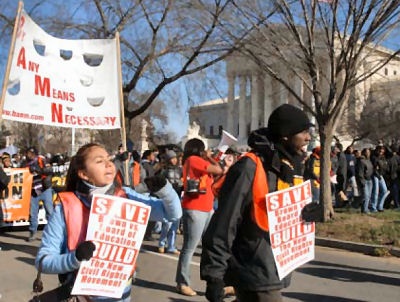Class action: A challenge to the idea that income can integrate America's campuses

By Nikole Hannah-Jones, ProPublica
Affirmative action occupies a telling place in a nation painfully aware of its racial inequities yet painfully divided over how to solve them.
Great numbers of Americans support the overarching goals of assuring equal access to educational opportunity and maintaining racial diversity in the country's institutions of higher learning. At the same time, polls show Americans are deeply conflicted -- often along racial lines -- about policies that achieve those goals by allowing colleges to use race as a factor in their admissions decisions.
The latest chapter in this national struggle was supposed to come with the U.S. Supreme Court's consideration of an affirmative action case involving a white student and the University of Texas. But the ruling -- announced Monday amid much anticipation -- merely sent the case back to the lower courts for reconsideration.
Afiirmative action, in its threadbare form, lives for now. But there was enough in Monday's opinion to suspect it will be diminished further in time.
All of which makes it an opportune moment to think again about what some people think could be a fairer and more palatable way of ensuring diversity on America's campuses -- affirmative action based on class. The idea seems simple enough: This approach would give poor students of any race a helping hand into college, and any policy that gives an admissions boost to lower-income students would naturally benefit significant numbers of black and Latino students.
Richard Kahlenberg, a senior fellow at the progressive think-tank The Century Foundation, is one of the principal proponents of what has come to be called "the economic integration movement."
"My primary interest is in ensuring that we have a fair process that looks at the biggest disadvantages that people face today, which I see as class-based," Kahlenberg said in a recent interview. "That will end up helping low-income and working-class students of all races."
Kahlenberg knows that many dispute this belief. But he says skepticism directed at the class-based solution has to be weighed against its dim alternative: If race-based affirmative action disappears with no program to replace it, African Americans and Latinos on college campuses will disappear too. Studies show that African-American and Latino enrollment at the nation's top 200 colleges would plummet by two-thirds if colleges stopped considering race when deciding whom to accept.
Yet ignoring race does not wipe its effects away. A formula that uses class while disregarding race may be politically popular, but many scholars say race remains so powerful a factor that a class-based system would seriously reduce black and Latino representation at American colleges from their current levels.
At the heart of their argument: Poor white Americans are still privileged when compared to poor African Americans and Latinos. Use class as the basis for admissions preference, studies show, and the nation's colleges will be flush with poor white students. "There are disadvantages that accrue to African Americans and Latinos that are not explained by class," said Anthony Carnevale, director of the Georgetown University Center on Education and the Workforce. "You simply cannot get race by using class."
(Live, Tuesday 3 pm ET: Join Nikole Hannah-Jones on Reddit to Discuss The Abigail Fisher Case)
* * *
The idea of abandoning race for an admissions system targeting those clinging to the bottom rungs of the economic ladder holds powerful sway for many who believe that in modern America race is no longer much of an obstacle to success.
There is no doubt that the greatest imbalance in American colleges is not white versus black or male versus female. It is the wealthy versus everybody else.
Kahlenberg asserts that affluent students -- those whose families earn at least $123,000 a year -- outnumber poor students by 25-1 on the campuses of the nation's most select schools. He said that while white Americans are twice as likely to earn a college degree as black Americans, the affluent are seven times as likely to earn one as the poor.
According to the most recent data available, about three-quarters of students at the nation's top 146 universities come from families in the upper quarter of the nation's economic scale. Just 3 percent come from the bottom quarter. A study released this year by The Brookings Institution documented how selective colleges enroll nearly all of the high-achieving high school seniors from families in the highest income quartile, but just one-third of the top low-income students.
Lani Guinier, a Harvard law professor who filed an amicus brief in the Fisher case supporting race-based affirmative action, said all the focus on the unfairness of race preferences ignores the bigger problem.
"Students who are getting into institutions of higher education tend to be upper middle-class students and they are the ones who are getting a preference," Guinier said. "Their preference comes from their parents' ability to spend a lot of money preparing them for SAT's and other college entrance exams and even hiring coaches to help them draft their personal statements."
And it seems that Americans, when asked, think that inequity should be fixed. While divided about racial preferences, polls show that about 85 percent of Americans approve of policies that offer special advantages or treatment for the economically disadvantaged.
So what's the problem? Poverty does not produce an equal opportunity burden across racial lines.
Being poor simply does not sequester white and Asian Americans from opportunity in the same way as African Americans and Latinos.
The typical low-income white American lives in a neighborhood where just one in 10 of their neighbors is poor, according to U.S. Census data. Their children typically attend middle-class schools where they benefit from the same qualified teachers and rigorous college prep curricula as their wealthier classmates.
The experience of poor African Americans and Latinos is starkly different. The typical poor black family lives in a heavily segregated neighborhood with twice the poverty rate of their white counterparts. Their children largely attend racially isolated, high-poverty schools, which are often burdened further by substandard teachers and a dearth of college prep classes.
Even middle-class African Americans and Latinos -- whom many Americans do not believe deserve affirmative action -- often cannot gain entry to better neighborhoods and top-notch schools. Affluent African Americans and Latinos live in poorer neighborhoods on average than working-class white Americans, a Brown University analysis of 2010 U.S. Census data showed. As a result, most black children -- regardless of their family's income -- attend schools where two-thirds of their classmates are poor and resources and college prep courses are limited.
That poor white and Asian students are not generally consigned to deeply poor neighborhoods and their failing schools, experts say, helps explain why white and Asian students account for nearly all (84 percent) of the nation's low-income students who are considered high achievers -- defined as students with an A-minus average who score in the top 10 percent on the SAT or the ACT. And under a strictly class-based system, these experts argue, these high-achieving low-income students would snap up the open spaces at top colleges.
For black and Latino students, then, a set of affirmative action programs that treat class preferentially could be disastrous. Some studies have shown that a college admissions system that favors the poor would indeed boost enrollment of working-class students -- making them as much as 40 percent of the student body -- but it would sink black and Latino enrollment. Representation of blacks and Latinos in college could fall from its current 16 percent into the single digits.
Carnevale and his Georgetown colleague, Stephen Rose, have studied the degree to which affirmative action programs targeting class can produce a more economically diverse student body while maintaining current levels of black and Latino enrollment.
Rose said colleges would have to recruit seven to eight poor white students to get one black or Latino student. Unless colleges set aside close to half of their seats for class preferences, Rose said, black and Latino enrollment would decline severely. And, he said, class preferences that look only at the poor would also disadvantage middle-class black students trapped in high-poverty, high-crime neighborhoods and struggling schools.
"The common view is that it's really not race, it's class -- you get that from left, right, black, white," Carnevale said. "It is true that higher education has all but ignored class. But that doesn't change the fact that African Americans and Latinos are disproportionately excluded from selective colleges and college in general. It isn't either/or."
(Related: What Abigail Fisher’s Affirmative Action Case Is Really About)
* * *
Both Kahlenberg, the champion of economic integration, and Carnevale and Rose, the skeptics, agree that an effective way forward would be to use both class and race in the admissions calculus.
Kahlenberg, for his part, would like to target race without being explicit about it. He is against a narrow, income-based admissions program that only looks at how much a student's parents earn in their jobs because it would be "unfair to African Americans and Latinos students who on average face substantial obstacles that whites of similar income do not face." He proposes an elaborate array of tools admissions officers could use. Universities should determine the wealth, net worth, education and occupations of a student's parents, he said, and consider as well whether applicants live in neighborhoods of concentrated poverty and come from single-parent homes.
"Under that program, you will take up lots of African Americans and Latino students," he said. "But that is different than a program that says, 'Check a racial box.'"
Rose and Carnevale say that Kahlenberg's approach might appeal to Americans ready to embrace a post-racial American ideal, but it still won't work. They spent years working as researchers at the standardized testing giant, Educational Testing Service, trying to find the "holy grail" -- the class dynamics that could negate the role of race in educational opportunity. They looked at the factors Kahlenberg suggested and then some.
"We were trying to prove that you get race by getting the right socioeconomic factor," Carnevale said. "We can never do it."
Carnevale said the only way colleges can maintain black and Latino enrollment in a nation where soon half of all school children will be of color is to continue the unpopular but successful practice of explicitly taking race into account.
"We want to figure out ways to get race without using race -- if it weren't so tragic it would be funny," said Carnevale. "The bottom line is race and class are not the same thing. There are a lot of ways to be unequal but race is still the worst -- it is still the one you don't want to be."
Tags
ProPublica
ProPublica is an independent, nonprofit newsroom that produces investigative journalism in the public interest.
